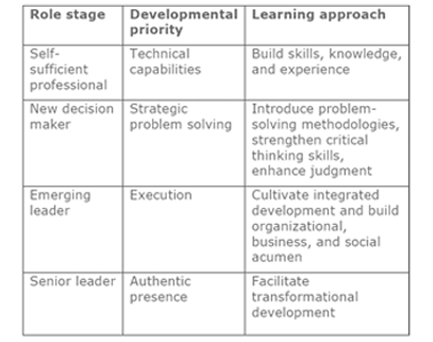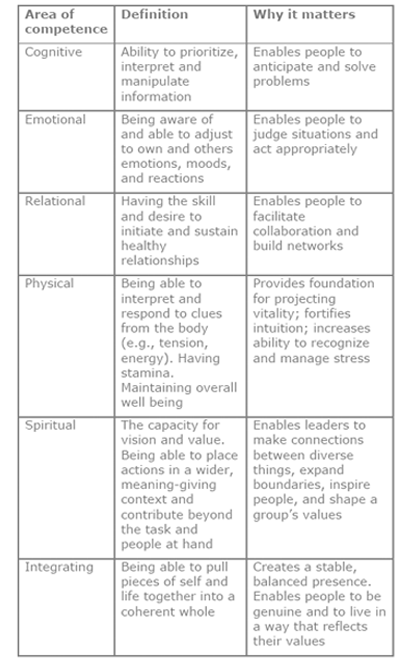 |
 |
|
 |
 |
Organizations usually know what they want from their people 每 even
if they haven*t articulated it 每 but aren*t always sure how to help
people change and grow. They recognize that developing a person*s
leadership capacity requires more than just increasing skills, knowledge,
and experience.
To ensure people develop as they work, organizations should use
rigorous, pedagogically sound approaches. They should be based on
proven models of how adults learn and grow and be structured around
clear outcomes. In addition, approaches should increase people*s
learning skills so they can correct themselves when they get off
track and navigate from learning curve to learning curve.
Being aware of one*s development stage, developmental priorities,
and desired outcomes accelerates growth. Generally speaking, high-performing
professionals transition through four role stages. To perform well
at each stage, a person must have specific competencies and an appropriate
way of acting (e.g., relating to self and others). We*ve all seen
the damage done by a leader who is intelligent and skilled but not
developed enough to handle a situation.
The following section outlines learning approaches that will accelerate
growth at each stage.

Improve learning skills while developing technical capabilities
Most self-sufficient professionals easily master the skills and
knowledge necessary to perform their role competently. Encouraging
them to adopt new learning approaches will help quickly scale learning
curves.
While enhancing their technical capabilities, learners should focus
on
 |
  |
Learning to ask questions
每 particularly questions that help them articulate their
perspective and assumptions. This helps them embrace
the complexity of a skill, topic, or situation and also
increases their self awareness. |
  |
Becoming self-correcting. Learn what
excellence looks like and how to improve quality. |
  |
Gathering robust feedback. This gives
learners the data necessary to self-correct. It also
builds their network of support by involving others
in their learning. |
|
These learning skills are particularly important for people who
have been educated in China. China*s education system rewards people
who know the ※one right answer§ and can recall copious amounts of
information. Helping young Chinese professions to think critically
about what they are learning and how they are performing will accelerate
their learning and help them apply what they are learning to the
real world.
Strengthen problem solving skills by focusing
on methodology, critical thinking, and judgment
Given China*s tumultuous operating environment, leaders must be
able to solve complex problems. This requires quickly identifying
the essence of a problem, determining the best tools and approaches
for tackling specific issues, making sense of ambiguous data, developing
a systems perspective, and crafting pragmatic recommendations.
Although few people begin their careers with strong problem solving
skills, with proper training and coaching, most intelligent people
can become solid problem solvers. Focusing on the following three
areas accelerates this process:
 |
  |
Problem
solving methodology. Introduce a formal approach
to problem solving that includes problem definition,
problem structuring, tools and frameworks (e.g., Porter*s
Five Forces). Provide practice (e.g., problems, projects,
case studies) to enable learners to become fluent with
different methodologies. As they build their skills,
help them to select the best tools for any situation. |
  |
Critical thinking
skills. Teaching thinking draws upon methodologies
traditionally used to teach mathematics and writing.
Start by developing dexterity in logic, drawing comparisons,
and relationship mapping. Transition to systems thinking
and constructing multiple perspectives. Throughout the
process, encourage learners to synthesize rather than
merely summarize and to push from conclusions to implications. |
  |
Judgment.
Training people to systematically direct their attention
to specific aspects of a problem or situation broadens
their perspective (e.g., illuminates implications) and
enriches their experience. In addition, problem solvers
should be encouraged to build broad, diverse networks
to tap into organizational memory and the wisdom of
their peers. |
|
Cultivate integrated development
Execution is a key development need for most emerging leaders. Execution
is not just a matter of doing things oneself, but getting entire
groups to make things happen. To do this, leaders need to act strategically
while also attending to people.
People rarely choose to follow someone simply because of their abilities
and knowledge. They seek leaders who are competent, inspiring, genuine,
courageous, honorable, and committed. Emerging leaders need to be
aware how their decisions and actions affect others, quickly notice
when things are not working, and modify their actions real-time.
Many professionals have the technical skills to manage, but miss
the ※something else§ that makes them a leader. For most people,
developing this requires honing hard and soft skills and making
cognitive and behavioral changes. Furthermore, to teach emerging
leaders to deal with complexity, learning and development should
be integrated into day-to-day challenges, which are far more complex
than any case or course material.
So how do you help someone make changes that will increase their
leadership effectiveness?
Who we are determines and defines how we lead. Developing the personal
qualities necessary to be an effective leader involves enhancing
awareness of self and others. It requires a willingness to reflect
on and learn from our experience.
At this stage of development, it is essential to use an approach
that recognizes how complex people are. Leadership competencies
therefore comprise a range of dimensions including cognitive and
emotional intelligence, relational skills and self-awareness, as
well as the ability to connect to a larger vision and integrate
multiple competencies.

These multiple competencies provide a foundation that supports leaders
as they navigate through complex challenges.
As Chinese and western managers help their companies expanded overseas,
they are discovering the importance of multiple competencies. Understanding
the market and developing a sound strategy requires cognitive intelligence.
Executing the strategy attracting staff, developing clients or customers,
delivering excellent service 每 requires much more. Leaders need
to make personal connections and build relationships with people
with different backgrounds, mindsets, and habits. This requires
not just emotional and relational competencies, but also physical
awareness and resilience to manage stress and project presence.
Leading any group, especially a multicultural group, in creating
and fulfilling an inspiring vision requires spiritual depth. Given
these and other demands, the ability to integrate multiple competencies
is crucial to sustainability.
At this stage of development, learning involves articulating desired
outcomes, becoming aware of gaps between desired and actual performance,
and developing and executing strategies to close these gaps. Integrated
development involves enhancing awareness and helping a person learn
to correct him or herself by building underlying competencies that
influence performance.
Facilitate transformational development
Shifting from managing to leading and from leading in a routine
situation to leading a group through adaptive change requires fundamentally
changing our modus operandi 每 how we act or show up in the world.
In today*s rapidly changing world, leaders need to help organizations
become what they need to be, not merely sustain what they are. Resolving
China*s toughest challenges, such as increasing the living standard
in China*s western provinces, will require leaders who are able
to help groups see themselves from a new perspective and shape their
future by making courageous and productive choices. For example,
as China*s agricultural industry develops, fewer farmers will be
needed. Farming communities will need to adjust their economies
and equip younger generations to thrive in an urban environment.
Leading communities through this adaptive challenge will require
mature leaders who are continuously learning and transforming themselves.
How to you help someone transform their leadership style?
Because our actions and reactions are guided by how we interpret
the world around us and our view of ourselves, acquiring new skills,
knowledge, or experience is not enough. Making this transition requires
changing our self image and how we relate to ourselves and others.
Most professional development efforts focus on enhancing our ability
to perform, but to perform within the world as we see it using variations
of a known approach. Transformational development involves moving
beyond our current view of the world, exploring our hidden assumptions
and inner contradictions, and developing the capacity to act differently.
How can an organization support leaders in this sort of development?
Transformational development can be stimulated by new roles, structured
interventions, and experiences that nurture awareness and cause
people to re-examine their assumptions. Many organizations have
found sending someone on an overseas assignment or to solve a tough
problem with a new group of people (e.g., PMM or turnaround) helps
them transform.
Because transformational development involves changing how we view
ourselves, a supportive community is essential to nurturing this
type of growth. People need to share experiences with and bounce
ideas off of others who are also engaged in inquiry.
Download
article |
| |
|
 |

